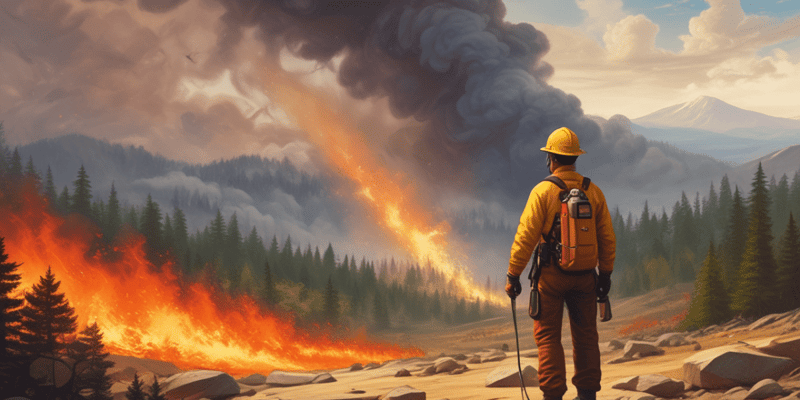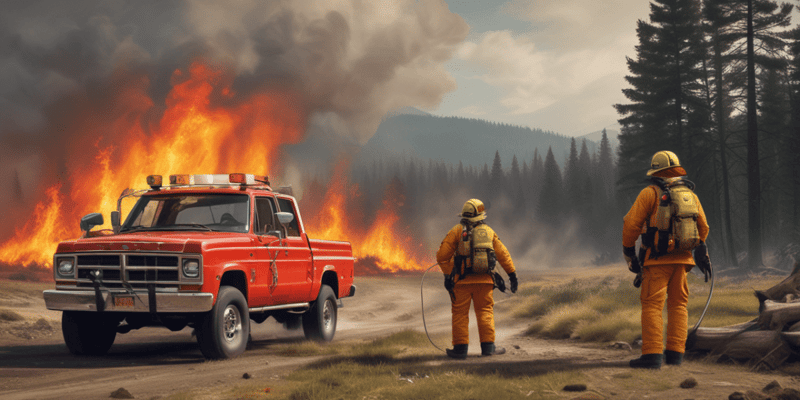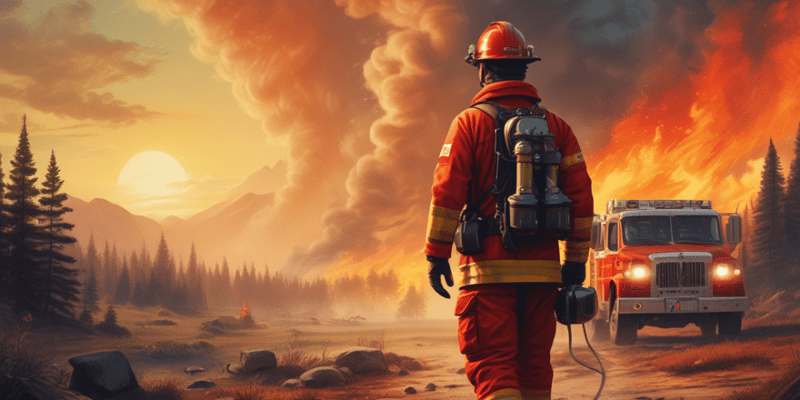Questions and Answers
What is a critical concept regarding team size while working on wildland fires?
Where should firefighters position themselves when fighting wildland fires to enhance safety?
What equipment is essential for firefighters to wear during wildland fires?
What is a necessary practice when operating apparatus in rough terrain during wildland firefighting?
Signup and view all the answers
Which of the following is NOT recommended when engaging in firefighting operations?
Signup and view all the answers
Which of the following is a Standard Firefighting Order?
Signup and view all the answers
Which situation does NOT shout 'Watch Out'?
Signup and view all the answers
Which action is NOT part of the Standard Firefighting Orders?
Signup and view all the answers
What is a recognized hazard in the '18 Situations That Shout Watch Out'?
Signup and view all the answers
According to the Standard Firefighting Orders, which is an essential communication practice?
Signup and view all the answers
Study Notes
Wildland Fire Safety
- Keep informed on fire weather conditions and forecasts to make informed decisions.
- Constantly monitor fire behavior and adjust actions accordingly.
- Identify escape routes and safety zones and communicate them to the team.
- Post lookouts when danger is possible to ensure situational awareness.
- Stay alert, calm, and think clearly to make decisive decisions.
- Maintain open communication with team members, supervisors, and adjacent forces.
- Give clear instructions and ensure they are understood to avoid confusion.
- Maintain control of forces at all times to ensure safety and effectiveness.
- Prioritize safety when fighting fires aggressively.
18 Situations That Shout "Watch Out"
- Never fight a fire without scouting and sizing it up first.
- Avoid fighting fires in unfamiliar terrain without daylight reconnaissance.
- Always identify safety zones and escape routes before engaging with the fire.
- Stay informed about local weather and fuel conditions that can affect fire behavior.
- Ensure clear understanding of strategy, tactics, and hazards before engaging with the fire.
- Verify clear instructions and assignments are given and understood.
- Maintain a communication link with crew members and supervisors.
- Never build a fireline without a safe anchor point.
- Avoid building a fireline downhill with the fire below.
- Never attempt a frontal assault on a fire.
- Ensure no unburned fuel exists between you and the fire.
- Always maintain visibility of the main fire or contact with someone who can see it.
- Avoid being on a hillside where rolling material can ignite fuel below.
- Be aware of increases in temperature, dryness, and wind that can affect fire behavior.
- Monitor for frequent spot fires across the line.
- Be cautious of terrain and fuels that make escape to safety zones difficult.
- Be aware of physical and mental fatigue that can impair decision-making.
Critical Concepts for Wildland Firefighting
- Always attack a wildland fire from the burned side (black).
- Wear appropriate personal protective equipment (PPE) at all times.
- Never ride on the outside of fire apparatus.
- Always work in crews of at least two people.
- Begin attacking a fire from a safe anchor point.
- Use a spotter when driving apparatus in rough, dangerous, or uneven terrain.
- Call for help and/or mutual aid early to ensure sufficient resources.
Studying That Suits You
Use AI to generate personalized quizzes and flashcards to suit your learning preferences.
Description
Test your knowledge on wildland fire safety and the standard firefighting orders. Learn about fire weather conditions, escape routes, and safety zones.




